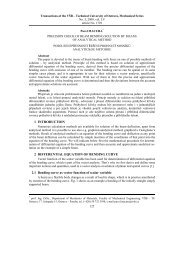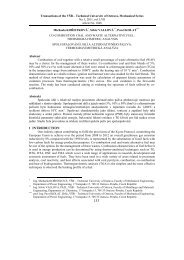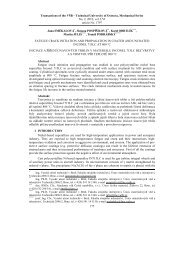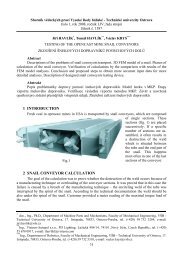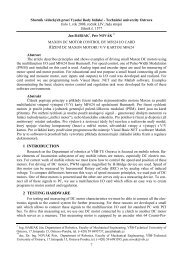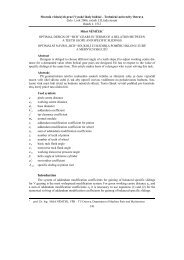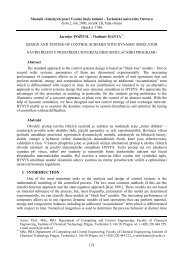SbornÃk vÄdeckých pracà Vysoké Å¡koly báÅské ... - Transactions
SbornÃk vÄdeckých pracà Vysoké Å¡koly báÅské ... - Transactions
SbornÃk vÄdeckých pracà Vysoké Å¡koly báÅské ... - Transactions
You also want an ePaper? Increase the reach of your titles
YUMPU automatically turns print PDFs into web optimized ePapers that Google loves.
Let us also remark that if then equation (9) is unstable for rationally independent 1 delays,<br />
[2, 3]. Moreover, in such a case, the closed loop system has infinitely many unstable roots.<br />
5 CASE STUDY RESULTS<br />
In this section, first we study the effects of small delays in the closed loop system (1) - (2) for<br />
the feedback gain derived in [1]. Next, we design a feedback gain which provides strongly stable<br />
solution of the system.<br />
5.1 Analysing the effect of delays in the vibration suppression example<br />
Recall the system (1) presented in section 2 and consider the stabilising state derivative<br />
feedback gain matrix from [1]<br />
The corresponding roots of the closed loop system are<br />
and<br />
. The transient response of this delay free closed loop system from an<br />
initial state<br />
can be seen in Figure 2-left. The system response<br />
shows desirable characteristics, namely a settling time of approximately .<br />
Now the effects of small uncertain delays in the feedback loop are analysed. Consider the<br />
vibration system in the form of (8), i.e. with delays at the system inputs. Even though the values of<br />
the delays are not known, for demonstration purposes we consider them here as .<br />
Evaluating the strong stability condition according to (13) results in . Thus the difference<br />
equation associated with the closed loop system is not strongly stable. Notice that the delays are<br />
rationally independent, therefore the system is not stable, as can be seen from the responses in Figure<br />
2 - right. This fact can also be verified by computing the spectrum of the system, using e.g. the quasipolynomial<br />
based root-finder (QPmR) presented in [13].<br />
(14)<br />
Fig. 2 Response of the closed loop system (1)-(2) with the gain (15): left – no delays, right – delays<br />
at the inputs.<br />
1 Delay terms e.g. and are deemed to rationally independent if their ratio is an irrational number.<br />
59




